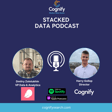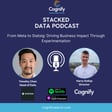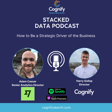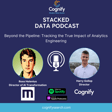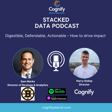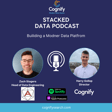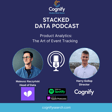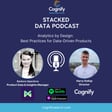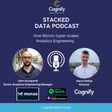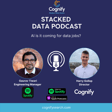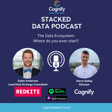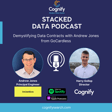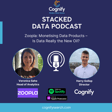Become a Creator today!Start creating today - Share your story with the world!
Start for free
00:00:00
00:00:01

032 - The key principles behind high-value data teams
Building High-Value Data Teams and the Future of BI with Oliver Hughes, CEO of Count
In this episode of the Stacked Data Podcast, we're joined by Oliver Hughes, CEO of Count — a business intelligence platform reinventing how teams collaborate through a flexible, canvas-style interface.
Together, we explore:
- The key principles that make data teams truly impactful
- Why operational clarity, effective problem-solving, and reducing time to value are so critical
- How Count's unique approach is transforming data collaboration beyond traditional dashboards
- The future of BI and how data teams can stay ahead in a fast-evolving landscape
Whether you're leading a data team, building one, or looking for smarter ways to drive insights, this episode is packed with valuable lessons.
Tune in and discover a smarter, more collaborative future for data!
Transcript
Introduction to Stacked Podcast
00:00:02
Speaker
Hello and welcome to the Stacked Podcast, brought to you by Cognify, the recruitment partner for modern data teams. Hosted by me, Harry Gollup.
00:00:13
Speaker
Stacked with incredible content from the most influential and successful data teams, interviewing industry experts who share their invaluable journeys, groundbreaking projects, and most importantly, their key learnings.
00:00:25
Speaker
So get ready to join us as we uncover the dynamic world of modern data.
Innovative BI Approaches with Oli Hughes
00:00:34
Speaker
Hello everyone, welcome to another episode of the Stacked Data Podcast. Today, we're diving into a fresh approach to business intelligence and collaboration with Oli Hughes, the CEO of Count.
00:00:48
Speaker
Unlike traditional BI tools that focus on dashboards and static reporting, Count introduces a canvas style interface designed to make data work more collaborative, flexible and impactful.
00:01:01
Speaker
In today's episode, we're going to talk about the key principles behind high value data teams and why operational clarity really matters, how problem solving and reducing time to value are critical for data to success, and why Counts Canvas based BI is refining how data teams work with data.
00:01:20
Speaker
So, Oli, great to have you on the show. been a long time in the making, actually. I've i've had a multiple people in my network say we should get you on. So, yeah, really appreciate you joining me.
The Vision Behind Count's BI Tool
00:01:30
Speaker
You're welcome, Harry. Yeah, pleasure to han Thanks for having me. I'm very fatted that people want me to come chat. I'm always happy to chat about data teams whenever people ever want to chat. That's fine.
00:01:38
Speaker
Brilliant. o i for For those that don't know you, Oli, it'd be great to get a bit of an introduction to yourself and I suppose the story behind Count and where the inspiration come from. Sure.
00:01:48
Speaker
Yeah. So as you mentioned, Count, we're a ah Canvas-based BI tool. We're often very fat and really called like the Figma for data because the primary interface of our BI tool is an infinite canvas, which is where analysts data teams work and can collaborate with the business stakeholders. But then you obviously have a reporting layer as well It's been a long time the making, actually. My background is I used to work in data, first Innocent Drinks, then at Tesco. I really cut my analytical teeth for a while and then ended up running a a sort of small data practice and ah at a consultancy firm for a bit before starting Count. And I, i yeah, the the story is long-winded, but i broadly, I think what really got me my co-founder, who's also called Oli, going was just
00:02:28
Speaker
just seeing how dashboards were like ubiquitous across the entire market that we had.
Limitations of Traditional BI Dashboards
00:02:33
Speaker
I was using all these different Power BI, Tableau, ClickView at the time, shows how old I am. There's all these different BI tools. and And even now in the market, you know the one thing which makes every BI tool a BI eye tool is that it has a dashboard in it.
00:02:47
Speaker
And we were looking at this thinking, this can't be the best way with all the technology we have, all the product thinking we've now developed, particularly in other sectors, that this is the best way to disseminate information around the business that we you know they were calling themselves, they still do, decision-making, the decision-making tools support decision-making. And ultimately these BI ah tools are just pumping out dashboards and they're not really supporting decision-making at all. So we set up account, we looked at a few different interfaces, like we were originally a notebook tool. And then we realized that There needs to be a bigger leap, and that's what they led us to the Canvas-based
Redefining Data Team Roles
00:03:20
Speaker
interface. And it's been a really great journey since we launched that about it a few years ago.
00:03:25
Speaker
We've really, I think, got to the point we've proven that yeah there is a better way to interrogate and work with data in a business, which allows you to present bit differently, collaborate more, and just break out of the service trap, which is really what's been driving us to find this better solution, was just seeing that the data teams are just enormously undervalued, they're enormously subservient to the but business asks, even if the business asking for rubbish, data teams have to provide it, and wanting to make the data team's role substantially more valuable, which which I think, and we know that they are.
00:03:55
Speaker
Yeah, it sounds it's that fascinating. I think it's it's clear that there's, we've had several other guests you know talking about the problems of just being a reporting function. I think you know reports to have their time and place and need to be part of the data team, but you don't want to get out because you said in that in that trap of of just churning reports. But before we dive into, i suppose, Cal, I'd love to talk a bit more about what are the sort key characteristics of building a high performing, high value data team.
Principles for Successful Data Teams
00:04:26
Speaker
I understand you've done quite a bit of research on this as you're sort of scoping out Cal. When you have such a new tool, like a new way of doing BI, like but yeah with Count, it is a completely different interface. you know No one else is writing. gives you a canvas to build queries, to build visuals, to present your numbers, to work in. So it's also a very flexible interface. So that it really begs the question for us, well, okay,
00:04:49
Speaker
we've broken out of the the dashboard paradigm and this wall that it leaves the data team behind this dashboard and the business can't engage with them very well. what is it you know What's the better way of working? So we did a lot of research over the last few years just to look at with the data teams who are really at the core of their business, driving value. How do they operate and how do they operate differently to those who are perhaps stuck in that service trap approach?
00:05:14
Speaker
And it came up we came with this idea of the tenants, this idea of that there are four ways that their data team should operate which we've built into our product count, but most importantly, we just think they're true. That is a way it is the North star metrics of a data team who succeeds basically. And yeah, it's been really great to see we've worked with over 200 different data leaders to do this, both customers and not, to really get confidence that these principles are generically true,
00:05:38
Speaker
They are the way that data teams should to provide value. And I think gives the data world, our data teams, a ah definition of what their role should be about, which I think actually is missing in data generally. like I think if you were to ask 10 data leaders now, what is your role? What are the requirements of your role? They talk about clean data and reporting, but they'd be very wishy-washy about what is really their purpose and responsibility.
00:06:01
Speaker
And the same would be true from the CEO of those companies. you know what are the What is the role
Creating Clarity in Data Teams
00:06:05
Speaker
of your data team? That's not true in product and marketing. Product and marketing have very clear responsibility areas and it's clear how they drive value. And I think we need that in data.
00:06:14
Speaker
We need a framework of what we think a data team who's valuable is doing differently and better than those who aren't, other than just just building stuff. And that's really what's excited me most about this is that we've got that consensus with our group people we work with, which is really cool.
00:06:28
Speaker
That isn't answered your question, but it sets sets it up very well. I was going to say, your I suppose what you're leading to there where is's is really around clarity. You said how the data key but isn't clear on maybe how it's driving value and the business isn't clear on what the data team can can leverage. So how do you define that, I suppose, operational clarity and and why is it so critical?
00:06:50
Speaker
Well, let let me so let me operational clarity is one of the principles we think is tied to value. So if I just set the scene. So we think there are four principle ways a data team should work, which if you're doing these four things and they're a journey, right? There's not like you are a tick box. like These are principles you can apply across the way you work.
00:07:07
Speaker
There are four of them. One is operational clarity. The other one is problem solving. The other one is minimizing time to decision. And the other one is measure yourself. These are the four principles that they kind of the community data leaders that we work with.
00:07:18
Speaker
have sort of come up with as like, these are the ways that we think drive value. This is the definition of a data team who's driving value. And as you rightly said, clarity, this idea of operational clarity is like, is perhaps the most, the probably the biggest revelation of the piece of work. It's the one which is probably least, most surprising.
00:07:35
Speaker
And operational clarity is this idea that a data team's job and what your data team is unique to be able to is because it has all the organization's data under its responsibility is help the business understand itself better. That the failure here is if you just keep providing dashboards and assets into the business, giving them data models they can build from and just pump more access to data sort of indiscriminately into the business, you're confusing the business. it's It's now drowning in information because every single SaaS product is giving business numbers, every single client's giving them numbers, and then the data team's doing even more.
00:08:13
Speaker
And if you're not careful about how you disseminate information, you're confusing the business and making it harder to move. So the principle that is operational cloud, that's the that the solution. The solution is to allow the business to see itself clearly.
00:08:26
Speaker
The data team's job is to create a signal from all the noise that's around there. Signal to noise duration needs to be high. So the data team's job instead of just making dashboards is to minimize the amount of assets, the amount of effort it takes for the business to understand itself and understand what really matters.
00:08:43
Speaker
To sort of made the business growth model really clear to itself, how it fits together. Interesting. So i so so one one of the things you picked up there it like reducing the amount of content. It's almost like that sort of dashboard bloat that businesses get.
00:08:58
Speaker
They are unable, you know, analysis paralysis almost, you're given their business doesn't know where to look for the right information to to answer the questions that they they want. and they They might end up sending another ticket and then there's another dashboard added to that.
00:09:13
Speaker
And it's a vicious cycle, actually, because the more information you give, the more confused they get, the more tickets they ask for, the more information they get. And it gets very it gets more and more, it gets worse and worse, basically. So yes, that's the alternative is to try and fix that by giving clarity, minimizing amount of information you have.
00:09:29
Speaker
Correct. so What are the other, I suppose, common barriers in achieving this sort clarity for data teams or a data leader? what What would they have to overcome and how would they overcome it?
Challenges in Achieving Clarity
00:09:40
Speaker
I mean, i want I'm not going to plug myself too much here, but what I will argue is that if your BI tool only lets you visualize dashboards as grids of numbers and you all you can do is contextualize the metrics as numbers with a title, that isn't helping you drive clarity. So that that's there's one very kind of physical constraint, which is,
00:09:57
Speaker
Dashboards do not contextualize metrics. They do not give you the ability to show metrics in context to each other, like a metric tree or a process flow map. So that's that's one limitation, lot not over not that you can't over overcome it.
00:10:09
Speaker
I think look the key here is that to achieve operational clarity, you've got to get the business to ultimately buy into a way of seeing itself that you're helping the business understand its growth model well. So if that is if the growth model isn't clear, if the business isn't aligned to what its North Star metric is or how it should how would they its you know revenue breaks down to different levels, then that can be a burden because you've got to then convince not just the um the definitions of the metrics, but actually define the relationships between them. So there's more information to codify then you can get away with the just of building a dashboard of you know random numbers.
00:10:43
Speaker
That's one thing. I find that's quite easy to overcome, actually. A lot of these metrics, there is a nascent understanding, but it's just then clarifying it can be can be quite useful. But that's that's definitely a thing, just that kind of the extra burden that it can put on you to define that stuff.
00:10:58
Speaker
But I think it's it's mostly just getting out of the ad hoc request engine to have space to build something more meaningful and build that kind of hero asset, which then lets you remove 10 other dashboards because they're they're duplicating what can be done in one.
00:11:14
Speaker
Yeah. And that brings us on nicely to, i suppose, the problem-solving aspect. And I think this is where I personally think Count really excels from what I'd seen of of the tall lolly because problem-solving for me is one of the core things that a data team is meant to do. you know but I think there's too much...
00:11:33
Speaker
emphasis put on technology and being best of coding. Actually, if you break down a data team, you have to solve business problems. That's what you're there to do. And I think dashboards can be quite a, not the best way in in solving that.
00:11:46
Speaker
And there have been, you how you do move out of that dashboard ticket churning process is to treat data more like a product. And product has been around, and product development has been around far longer than data and dashboards have.
00:12:00
Speaker
And I think this transition is where Cal can come in well because you have this, I suppose, more collaborative environment. Why do you think, yeah, that problem solving is so important? um And yeah, how does Cal U really tackle this?
Solving Business Problems with Data
00:12:16
Speaker
Yeah, i said you isn't it? So the the tenant of problem solving is a thing which I think everyone needs but i everyone I've spoken to, literally everyone I've spoken to has gone to David because they love solving problems and they don't do it because they end up just answering questions that the business asks.
00:12:30
Speaker
And so that's the failure is that the switch is going, I'm not just going to answer the business, ask me to, I'm going to help them structure the way they think better. I'm going to take the burden of the critical thinking burden and lay out my lay out the answer, lay out the story of this answer so that the methodology is clear, not just the answer. And that's the big unlock to making a data team become like the organization's like hit problem solvers. That's what I love hearing when I speak to our customers is they talk about how much more people rely on them to help them tackle k nitty, difficult problems because they're actually helping the business think rather than just being the data portal that they just the data the business is taking from them. So
00:13:08
Speaker
Yeah, I think it's very obvious in one way this is an important value lever, but it's also quite difficult to do um because of the way that it's hard for data teams to share methodology, to tell the story, to structure the problem solved on paper rather than the problem solving in someone's head and they're just asking random questions. So that's where Cal's useful because it's a collaborative canvas.
00:13:29
Speaker
It allows you to naturally blend business context, screenshots of your product, random CSV files that have been pumped out somewhere or whatever it is, and bring that in alongside the data warehouse and the visualization layer to like just lay out the problem-solve, discuss what you're seeing, both the qualitative and quantitative information in one place, and do that in a real time.
00:13:49
Speaker
that's That's why I think you're saying count's great because it's just a natural problem-solving place, just like other low-tech platforms low techch look Canvases like Miro or Figma you know allow that as well. It just bringing the data in as well just puts the data team as the hero in that experience. And it's just that, yeah, it's the ability to break the problem down, structure it as you know a tree of problem solving, you know breaking things apart, so talking through the problem.
00:14:13
Speaker
thats That's why it's... pretty great. But it's it's so important that their teams are solving problems. and If you think about it, if you're spending you know majority of your time just supporting reporting and supporting the kind of the reports the business needs to to work day to day, that is completely ah cost, an overhead to the business's margin. You're not driving business forward.
00:14:36
Speaker
You're helping the business maintain its current operational envelope. You're has to be helping it maintain its current margin, its current growth rate, you're not making it better. that's all what That's all cost, right?
00:14:47
Speaker
So the more the data team is focused on the problem solving, which drives the business forward, finds and unlock, helps the business grow and accelerate growth, that's the ah ROI. So data team's
Guidance for Data Leaders
00:14:58
Speaker
job is minimize the amount they're spending on the day-to-day to maximize time on the growth.
00:15:04
Speaker
Yeah. And I suppose, how do you do that, Ollie? I think that's one thing that I know there'll be the listeners, you know, they know that they want to be a problem solver. They want to try things forward. If you're a data leader, if you're ah a practitioner now, how can you go and try and punt out them opportunities to be a problem solver? Have you got any sort of I suppose, tangible advice?
00:15:23
Speaker
I think what I'm going to say it would be true if you're a new day leader going into your job. if you're as well as if you'll be If you're feeling stuck in a service trap right now, there are there are a few things you can do to break out of that. And they're the same things you would do if you joined a new company in new role.
00:15:36
Speaker
One is to understand how the business fits together really well for yourself. That links back to operational clarity, this idea of... Do you understand the growth model of all the business, how it fits together? Can you display that to the business? Because I guarantee you, if you don't understand it and you have all the data, all the metrics in your purview, there's absolutely no way anyone else in the business, any executive has a better view than you.
00:15:55
Speaker
So if you don't get the growth model, how it fits together, then no one else has got a hope to do it. So you've got to get clear yourself on how the business works. works, how it fits together, how metrics relate to each other. The more you can do that for yourself, the easier is to expect to the business. That is definitely a huge enabler of your clarity and your ability to help business so understand itself and solve problems.
00:16:16
Speaker
The second thing to do, which is linked to that, is either take that growth model visualization to the business and say, here's what I see. Does this make sense to you? Any questions? And just getting to answer questions on a structured visualization of the business will get much higher quality questions out the back of it than what they're thinking about in the shower, what they're thinking about in a meeting, and just giving you random questions that come from sparks of ideas that could be at any level of detail.
00:16:41
Speaker
Another of doing that is just to go meet your executive team, sit down with them, understand what their biggest problems are, and take it away and think about how you'd solve that. And then structure and lay out the problem solved before you even touch code. And just like, how would I tackle this problem?
00:16:55
Speaker
Send the structure how you tackle the problem back to the executive, get them but get their buy-in. And then you can help them actually think through the problem, not just be giving them numbers that they think they need.
00:17:07
Speaker
So does that make sense? It's subtlety here. Basically, what i'm saying is you have no idea how much more clear you can make the business to itself than than it is right now. And that's operational clarity.
00:17:18
Speaker
The more clear the business is, the better the questions that the business is going to ask of you, which means you that's the virtuous cycle that you can get into. The clearer, the better the questions. so That's one way to break service trap.
00:17:29
Speaker
The second way is just to go be of service, go speak to the executive teams and learn enough about the problem that you can help structure the problem, not just give to the answers. And then if you then you're then you're taking the subtle change there is that yeah yourre the data you as a data leader are owning the problem-solve framework, the structure of the problem.
00:17:51
Speaker
You're no longer just the number-generating machine. You're now the problem-solving owner and you're helping the business understand itself. So there's some very... tangible things that that you can do, you know, without regardless of BI tool you use. It's all about critical thinking and mapping, basically.
00:18:07
Speaker
Yeah, I think that's some great advice. Thanks for sharing that. i think it's always easy. It's easier to say these these things in passing and then, yeah, not to actually, I suppose, ah help people break it down like what you've just done there.
00:18:19
Speaker
I suppose one of the other quick key values, which is time to time to value, um which year you come up in your your
Balancing Strategy and Quick Wins
00:18:26
Speaker
survey. Obviously, time to value is a critical metric for data teams, especially if you're a new data leader or you're you're going on a transformation, you need to balance that, I suppose, short-term success and wins with long-term vision and and and and foundations, which are going to set you up for success down the future. So,
00:18:44
Speaker
Yeah, how do you balance that ratio and how do you as ensure you're achieving a good time to value in both the short term but also in the the longer term for the what overarching sort of strategy? Yeah, so actually the the term time to value, we actually have broken out into the into the last two tenets, we call them. One is time to decision, and then one is measure yourself. So i'm going to tackle, it's okay, I'll break that out into two different topics.
00:19:09
Speaker
See, the reason I did that is because when we spoke to day leaders, they were very clear that they they see these things as different. Like time to decision is the time to get value to the business. like that the business value is getting produced, the decision-making process.
00:19:23
Speaker
And how do you minimize that? And most most data teams try to do that by minimizing the time that they are engaging with the business and will instead try and just focus on like self-service opportunities that the business itself, um get questions themselves, or just will put up a barrier for ticketing, you know, put somebody to request and we'll and send the answer to you. they That's the way they feel they can scale.
00:19:45
Speaker
What we heard from these 200 plus data leaders was that that there's a better way to think, particularly the ones who are doing so well, is they don't think about it as self-service. How do we get self-service in there as like the main priority of our business, of our data team's ability to drive value? They think about it as saying, I look want to look at the entire spectrum of decision-making goes in my business, be it from the most operational decision to the most strategic decision.
00:20:11
Speaker
and understand how we can improve the decision-making process of all those different levels of complexity. So what I mean by that is self-service is a really, really, you know, like ah wherever you know like ah a data model that people can drag and drop from or use an AI bot to answer questions.
00:20:27
Speaker
It's a super useful way of getting... people who are maybe in customer success or in marketing to answer very quick questions they need operationally to understand things. you know It's a very great way to give people data for day-to-day jobs ready-to-day tasks.
00:20:42
Speaker
It's an important pillar of delivering time to decision for a portion of the decision-making that happens in a business on a week-by-week basis. It is not appropriate to support how the board makes decisions at the highest level on a quarterly basis.
00:20:56
Speaker
So if you think about that, you've got... You've got to think about the different decision making that's taking place at different cadences and support them appropriately and put in the right time at to the right places. So operational reports, want to understand what's the usage of this customer I'm going need tomorrow, you know, right now, give me the number. That makes sense from a sort of self-serve perspective.
00:21:18
Speaker
But for the board meeting quarterly to make the most important strategic decisions which can impact everyone else's jobs and the market's impact of the business, The data team should lean in heavily then in a very different way. And maybe we should spend hours with that that' be the CEO, with the seats the C-suite, help him understand the business in a really clear way because that decision point is really important. So the reason we call it time to decision is because you need to have a different interface, a different way of working, a different workflow to support...
00:21:48
Speaker
all the different decision-making types that happen in the business and treating them all the same causes like causes problems elsewhere, right? That's the problem. If you just say it's everything that is about self-service, you're just going to put the wrong solution in the wrong place at the wrong time for the wrong decision.
00:22:01
Speaker
And that's a really bad thing to do. So an example of that would be one of our customers is Bumble. They use Count for their executive reporting. They work with that for that executive reporting use case very differently. And they use Count very differently for that workflow than they would if they're trying to get you know a very great great simple data model for their customer success, customer support teams to get numbers out as they need. So the breadth and the range of the what they need what they use count for varies based on the decision type.
00:22:27
Speaker
That's broadly the idea of that tenant, that the best data teams are thinking about the decision type and then ah working a workflow appropriately. I think that's really good advice. I think there you know there's no one-size-fits-all solution, and that's essentially what you're saying. And this would be something that I think, you know, as ah i as a practitioner, you should be thinking about depending on the the type of stakeholder and type of problem that you're you're dealing with, or as a data leader, should be a framework that you're coaching and and training your team your team on as to how to to tackle them, which workflow you might choose. And it doesn't have to be an endless list, it sounds like. you It seems like you could break down some of these decisions, these types of decision-making into some key areas.
00:23:08
Speaker
And a great tangible way of doing it is to survey your team or at least audit your business and understand where your data team is being pulled in different directions and then working out the right intervention for that particular request type. so And that's a great way of breaking this kind of breaking out what the aggregate feels like into proper segments, which you can tackle individually. That's generally what I've seen data teams do so well is to to understand the needs at a lower level of detail of the business and say that marketing he need this, product need this, the board need this, and we're going to solve those and treat those differently.
00:23:40
Speaker
him ollie i'd love to talk a bit more on ah about actually count because i think uh there's obviously plenty of new bi tools on the scene each trying to tackle slightly different areas are i believe but counts one which i think in i'd encourage people to go and see it and so it's easier to to to see them maybe to to visualize but yeah i would love to hear i suppose how you're you're fundamentally different to to some of the others on the scene and but how your approach may leverage itself to some of the values that we spoken about today Yeah,
Transforming BI for Business Improvement
00:24:10
Speaker
sure. ah Well, of course, i can I can only give you my perspective on the market and what I think needs to happen. I won't speak to others too much.
00:24:16
Speaker
I guess, as I said, like the whole idea of Count has been inspired by this idea of how to break the data team out of a service trap mode and how to avoid the the data team to be seen as a kind of a support function effectively.
00:24:31
Speaker
And therefore, this is the reason we've done these tenants of operational clarity problem solving. So we're trying to work out what's the what's the work which is really valued by the business, which the data team should be focused on and making the tool fit to that really well. So put it another way, what we believe Count is for is is a is a BI tool, which is trying to drive business improvement. Like we would say that BI should stand for business improvement rather than you know, what it means now, which is to be a dashboard factory, that we believe that data teams are some of the best organizations problem solvers. They're one of the best critical thinkers. They have all the data of the business in one place.
00:25:04
Speaker
they They need a tool which allows them to serve the business as well as possible and facilitate the business in improving itself. And that that is an aspiration. Sounds very simple. but But it's a very different mindset to what I think the BI market has been focused on us so far, which has just been to make the data team's workflow focused on cost reduction and yeah building a dashboard as fast as possible. So I guess that's the...
00:25:31
Speaker
the simple TLDR is like we're a data, we're trying to, we believe that you need a different interface to operate a different way and to make that way more valuable. And that's why we we built the BI tool around this collaborative canvas. Now you can build dashboards in account. It's important to recognize that we are a BI tool under the hood, we do dashboard and we do all that kind of monitoring of KPIs that every dashboard does.
00:25:52
Speaker
And we do that really well, but we don't think that's enough for a BI tool to be anymore. That a BI tool, a data team needs to drive value, needs to have substantially more than just that kind of interface. And that's where yeah you can use the canvas to to branch out to different ways of working. So one would be building that you know operational clarity, using count to map out your metrics as metric trees or process flow maps, where you can have 60 metrics in one canvas with everything, showing the onboarding funnel of your your customers into your app or into your mobile app.
00:26:23
Speaker
And that's an incredibly great way to to visualize things. where I think you can put, well, you can put hundreds of charts in one canvas and count of that without zero performance loss. And there's no BI tool in the world who can do that level of mapping because they're built to put six charts on a page because it's dashboarding tool.
00:26:41
Speaker
So that's one very clear distinction that you can map metrics, map your entire business in one canvas. so like Tell me how, if I'm just ranting now, I can obviously get my pitching mode. i can I can switch. The second thing, and then obviously you alluded to is this data exploration piece. The the canvas can then not only be this kind of wonderful way to visualize your business and your growth model, but then it's a place to ah problem solve. You can write Python, you can write SQL in ah and also add in screenshots and just wrestle with data in this flexible way. And it's also collaborative process.
00:27:10
Speaker
It's fully real time. So you can bring your product managers, your analysts, your ana analytics engineers into the canvas to think through problems, to find data models, to find the analysis individuals, get business requirements and the scoping all in map in that one place together, rather than having to sort of cut and paste charts between eight different tools.
00:27:28
Speaker
And that also just minimizes time to decision enormously because you can actually, you're showing methodology, you're working through problems in an iterative way. So the way we describe count is, look, if you' if you're looking for a BI tool, which just lets you see the business and monitor KPIs, there's about 85 different tools out there, and I know them all.
00:27:46
Speaker
But if you're looking for a tool which does that, but also lets you improve the business by clarifying how business fits together, mapping the growth model, making sure everyone's on the set working on the most important things, and then lets you problem solve, wrestle with data, and make not just data exploration happen, but make better problem solving activity,
00:28:03
Speaker
then that's what we're unique for. And we're happy to say we've got hundreds of customers now who believe in one a different way of working and have got their business on site as well. And they've elevated that role of their team enormously as a result.
00:28:15
Speaker
Yeah, i as I said, I couldn't encourage people more to go and and have a look at Kel on their website in action. Because it has been something that I think as I know some of the the your customers not on the high street, Bumble, who have said it has really transformed them and there's that you needed to come on the show. And it's one of the ones I think you just have to see it to really believe it. Yeah. You do have to see it. That's fair. My enthusiasm can say a lot of hope. but And um obviously, it's wonderful that your community giving you recommendations to speak to us. But have to see it to believe it. Yeah, absolutely. That's that's fair.
00:28:48
Speaker
few more, I suppose, closing thoughts from yourself, Ollie, building a high-value data to team. man yeah we've touched upon some of the key aspects, but what advice would you give to organizations, data leaders, or practitioners in their world how they can elevate their own data team, their own data work to to drive more value for a business? What would be your sort of key take-homes?
Evolving Beyond Traditional Tools
00:29:13
Speaker
I think it's very difficult. I mean, I obviously have a very clear vision of what data team should be, that that they should be the drivers of business improvement. They should be the problem-solving experts in their organization. They should be the ones driving clarity to the business.
00:29:27
Speaker
And I think those things are true. I mean, I think i validated we validated that that is true with as many customers as non-customers. And I believe that there's a real way of working, which we now see data teams adopting, getting excited by the business, most importantly, getting excited by a higher functioning data team, which we are just seen as that support function to them, who are challenging them to think clearer, to help them solve their problems. it's ah It's a thing that everyone wants.
00:29:51
Speaker
So I think that's really, I'm really encouraged by that. I think it's important to people to recognize there is a better way of working where you are more valued, where are more efficient. And the problem, I guess, is that if i if I was to speak to the market, the tools that we're using now are 25 years old.
00:30:05
Speaker
You know, Tableau, which I used to be an absolute lover and fan, started in the early, early noughties. It's been around for over 20 years. It is no longer the it is no longer enough.
00:30:16
Speaker
It also was created in a world where just getting data into business was a big win. Now we have more data than we could possibly deal with. It is no longer enough just to pump more data into business with a dashboarding tool. So we we we are we haven't got the right tools, I think. That's the one thing I believe, obviously, as I build a product.
00:30:31
Speaker
i don't I think there's a better way of working. I think it' ah everyone wants that better way of working, which is more value add. And I think it is fair to say that the tooling we use is not helping us. The new tools in the market are just...
00:30:43
Speaker
cheaper versions of the same tools we've had for 20 years. and and And if anything, it just focuses on the cost-saving aspect of the the tool rather than the value-add generation of the tool. And I think that is tricky, but it doesn't mean you can't make improvements. You can always map the business clearer. You can always tell better stories.
00:30:59
Speaker
Maybe the best work from the world, but you can do that. And you have all the skills that your business needs. You have the ability to think critically, you have the all the data available to you in your business now, which is wonderful benefit of the the cloud data warehouse. It's just about how you present that back to the business is the way that you can drive more value, I think.
00:31:17
Speaker
That's ah a bit of a rant for you there, Harry, to finish. But as you can tell, I'm very passionate about it. I really believe that we... that data teams need to evolve. And I believe that there's an answer. And i would yeah, regardless of count, I would recommend checking out are um the tenants of a high-value data team. It's a free resource available to anyone who wants to work differently.
00:31:34
Speaker
They apply regardless of the BI tool you have. Now, clearly, we believe that count is the best way to execute that as a tooling perspective. But that doesn't mean you can't use the principles today with whatever tooling you have.
00:31:46
Speaker
Yeah, I think the principles still that was spoken about today are critical to the success. I think tooling helps those teams do what they should do better, but ah essentially nothing beats also I think having having conversations, building trust,
00:32:01
Speaker
with your with your organization. And so you mentioned about doing audits, you know, really understanding what the problems are. And even if you haven't got the world's best tooling, there are many ways where you can drive value for your team. I think that first and foremost, you've got to understand what the real problems are in the business.
00:32:18
Speaker
So yeah, Oli, it's been a pleasure to have you on. anyone wants to get hold of Oli, we'll do a link to his um LinkedIn in in the show notes. But yeah, thanks for joining me, Oli, and we'll see you soon. Harry's pleasure. Thank you so much.
00:32:30
Speaker
Bye-bye.
00:32:33
Speaker
Well, that's it for this week. Thank you so, so much for tuning in. I really hope you've learned something. i know I have. The Stack Podcast aims to share real journeys and lessons that empower you and the entire community. Together, we aim to unlock new perspectives and overcome challenges in the ever-evolving landscape of modern data.
00:32:54
Speaker
Today's episode was brought to you by Cognify, the recruitment partner for modern data teams. If you've enjoyed today's episode, hit that follow button to stay updated with our latest releases.
00:33:05
Speaker
More importantly, if you believe this episode could benefit someone you know, please share it with them. We're always on the lookout for new guests who have inspiring stories and valuable lessons to share with our community.
00:33:17
Speaker
If you or someone you know fits that bill, please don't hesitate to reach out. I've been Harry Gollop from Cognify, your host and guide on this data-driven journey. Until next time, over and out.
